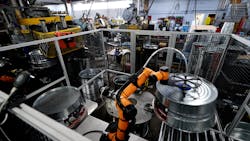3 developments changing the face of robot implementation
Jordan Kretchmer is co-founder and CEO of Rapid Robotics, whose robotics-as-a-service model has been implemented at Behrens Metalware.
What have been the biggest improvements to robotics technology in the past five years?
Jordan Kretchmer, co-founder and CEO, Rapid Robotics: At a very high level, software has been the biggest driver of growth and innovation in robotics in the past several years. Traditionally, robotics integrators program the robots they deploy using proprietary software that original equipment manufacturers (OEMs) provide. They functioned as walled gardens, safeguarding that software, which deterred innovation. Now, robot vendors use application programming interfaces (APIs), which can be tapped into by other vendors. This gives the newer players access to software innovations from different industries around the world, allowing them to create enhanced, dynamic software stacks.In addition to software innovations becoming more accessible, robotics hardware, such as sensors, light-detection-and-ranging (LiDAR) cameras and harmonic drives have also become increasingly inexpensive due to the economy of scale. LiDAR cameras, for example, used to be thousands of dollars; now we all carry them around in our pockets on our phones. All of this has led to improved vision system capabilities, enabling task-switching, significantly reducing time to deployment and introducing cloud connectivity. These enhancements allow newer players in the market to orchestrate intelligence systems, cameras, sensors, grippers and more to provide instantaneous value to customers at a much lower cost than traditional automation.
Regarding grippers, 3D printing has been another game-changer for the robotics space; it allows robotics vendors to create their own customized components like fixtures and grippers. One of the biggest benefits of this practice is that it makes these components more reliable; we can print parts that fit perfectly and are more durable. These components can be designed intricately, making robots applicable to more tasks. In addition to increased functionality, the use of additive manufacturing dramatically reduces the cost of obtaining components necessary for robotic integration, which, at present, is significant when added on top of already expensive equipment. Instead of waiting months for customized pieces to come in and paying thousands of dollars, businesses can 3D-print what they need in a matter of hours for a fraction of the cost.
What’s the most innovative or efficient robotics technology application you’ve ever seen or been involved with?
Jordan Kretchmer, co-founder and CEO, Rapid Robotics: Robotics technology in and of itself has only improved incrementally over the years; what’s valuable is how that technology has been applied to different use cases through software enablement and business-model innovation. In many cases, the most mundane of applications can be the most impressive because of the required technology precision and durability and the impact of that automation on the bottom line. For me, subscription-based, as-a-service models are revolutionary for the robotics space because of the possibilities they enable. There’s a lot more to them than this, but in essence this evolution enables robotics companies to become powerful extensions of their customers’ workforces.
Tell us about your company’s state-of-the-art robotics technology.
Jordan Kretchmer, co-founder and CEO, Rapid Robotics: The U.S. manufacturing industry is facing an immense labor shortage, especially in key machine-operator positions that supply lines rely on. Yet we don’t see small-to-medium-sized businesses, who make up the vast majority of U.S. manufacturers, investing in automation to remedy this problem. Why? Because robots have historically been designed for big players, leaving contract manufacturers facing barriers to automation like high capital investment, inflexibility and, ultimately, more risk than reward.
Rapid Robotics was created to democratize automation and, in doing so, help manufacturers increase return on investment (ROI) and competitiveness. We pair the latest in robotic-arm technologies with as-a-service characteristics like cloud connectivity and 24/7 support to power our unique workforce solution: the Rapid Machine Operator (RMO). The RMO is a fully integrated, purpose-built, six-axis robotic arm work cell that is designed to automate crucial but repetitive tasks so that valuable human labor can be redeployed to more complex work (Figure 1).
The RMO also includes a powerful feature called Smart Setup. It gives customers the flexibility to seamlessly move the RMO from one task to another in less time than it takes to make a cup of coffee, all through a simple tablet-based interface that anyone can use, not just robotics engineers. For high-mix, low-volume facilities and manufacturers undergoing instability, this means that changing contracts or production needs won’t lead to lost ROI or a growing machine graveyard.
Ultimately, our use of technology like computer vision, AI and instinctive learning combined with the robotics-as-a-service business model removes the risk of buying, deploying and managing a robot for contract manufacturers. The RMO's flexibility, high productivity, affordability and quick deployment make it a reliable workforce solution.
About the Author
Mike Bacidore
Editor in Chief
Mike Bacidore is chief editor of Control Design and has been an integral part of the Endeavor Business Media editorial team since 2007. Previously, he was editorial director at Hughes Communications and a portfolio manager of the human resources and labor law areas at Wolters Kluwer. Bacidore holds a BA from the University of Illinois and an MBA from Lake Forest Graduate School of Management. He is an award-winning columnist, earning multiple regional and national awards from the American Society of Business Publication Editors. He may be reached at [email protected]

Leaders relevant to this article:



